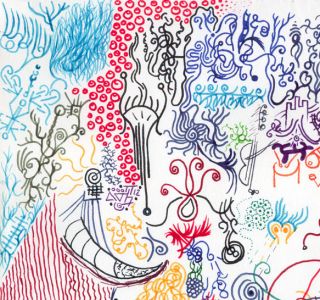Memory
Doodling Your Way to a More Mindful Life
The art therapy secret is out: doodling is good for you.
Posted January 13, 2014

Doodling, according Sunni Brown, author of The Doodle Revolution: Unlock the Power to Think Differently, claims doodling has gotten a bad rap. In her now famous TED talk, she proposes that doodling is deep thinking in disguise and that it is a simple, accessible tool for problem-solving in general. In fact, Brown believes doodling spontaneous marks actually helps you think.
By most definitions, doodling refers to the unconscious or unfocused drawings made while otherwise preoccupied. But that is not always the case. Like many people, I resort to doodling as a place of escape—from boredom waiting at yet another airport gate, a distraction during a long-winded lecture, or a way to pass time at a meeting. To me, doodling is purposeful action that more than mindlessness. Having watched a couple of thousand doodlers in art therapy sessions over two decades, they often find self-soothing in their mark-making. And all doodlers have a few enjoyable and pleasing patterns and images they return to again and again, just because they like them.
There is research that indicates that doodling is helpful in memory retention. For example, in one experiment (Andrade, 2010) participants listened to a mock phone message about an upcoming party and were asked to write down the names of people who could attend the party and ignore the names of those who could not attend. Half of these participants were instructed to fill in little squares and circles on a piece of paper while writing down names; the other half just listened to the messages and only wrote down names. Afterwards participants were given a surprise memory test, after being specifically told they didn’t have to remember anything. The doodlers performed better in memory retention-- almost thirty percent better.
There is speculation as to why doodlers did better than non-doodlers on this memory task. For example, doodling may help people concentrate because it prevents their minds wandering (common occurrence when bored) while allowing the person to listen. Doodling might also keep the doodler sufficiently engaged with the moment and able to pay attention to information presented; in other words, doodlers are actually not “spacing out,” but are at least somewhat “in the moment.”

Detroit Airport Doodle ©2013 C. Malchiodi
As I mentioned in “Visual Journaling, Self-Regulation and Stress Reduction,” Zentangle®, a purposeful, structured form of drawing that is similar to doodling, seems to support mindful states of being, but in a slightly different way. Reduced to basics, a Zentangle® consists of a series of repetitive strokes—straight lines, curves and dots—drawn on a three-and-a-half-inch square of high quality paper. Compared with the garden variety of doodling, Zentangle® is much more focused and deliberate, but still allows the “Zentangler” to be creative and free-form in using patterns, lines, shapes and shading. Preliminary studies and anecdotal reports seem support the idea that Zentangle® is a “meditative” art form that actually induces relaxation and has an impact on self-control, mood, and stress reduction.
Brown’s “doodle revolution” provides specific instruction on how to create an “InfoDoodle,” a practice of capturing information from a group into a large visual language format (reminiscent of the ubiquitous infographic). The InfoDoodle is obviously meant more for entrepreneurs and companies, but it can be applied to less lofty situations. I have to say that I was discouraged by mostly white male-oriented examples throughout Brown's book; for the most part, US Presidents’ and generally male scientists’ and innovators’ spontaneous mark-making were referenced. Didn’t women leave behind any doodles for this doodle revolution? On a planet where multiple cultures developed mark-making over millenia, Brown’s doodling advice curiously leaves cultural diversity out of the doodling picture, so to speak.
Despite this drawback, I do think that what Sunni Brown has created is of interest to the fields of art therapy, creativity, and the psychology of art and visual language. But there is still one very important point that is not quite accurate. Doodling is not just a way to “think differently;” it’s a way to “feel differently,” too. From emerging studies we are learning that art expression may actually help individuals reconnect thinking and feeling, thus bridging explicit (narrative) and implicit (sensory) memory. The wonderful thing about doodling is that it is a whole brain activity—spontaneous, at times unconscious, self-soothing, satisfying, exploratory, memory-enhancing, and mindful. In essence, doodling (and drawing and painting and making things in general) can be a self-regulating experience as well as a pleasurable road map of thoughts and ideas. That is what those of us in the business of encouraging people to self-express with pen and paper, pre-doodle revolution, have known for a long, long time.
Keep calm and doodle on,
© 2014 Cathy Malchiodi, PhD, LPCC, LPAT, ATR-BC
References
Andrade, J. (2010). What does doodling do? Applied Cognitive Psychology, 24: 100–106. doi: 10.1002/acp.1561.
Brown, S. (2014). The Doodle Revolution: Unlock the Power to Think Differently. New York: Portfolio Penguin.
Because many readers requested a way to obtain the information presented in the four-part series on visual journaling in one place, I created a summary that you can download on my author’s page. Just go to the lower right hand corner of the page, look for the “Visual Journaling as Art Therapy & Self-Help” PDF and click to download.
For information on Trauma-Informed Art Therapy®--- visit Trauma-Informed Practices and Expressive Arts Therapy Institute at www.trauma-informedpractice.com
Follow Planet Art Therapy Twitter at https://twitter.com/arttherapynews
Art Therapy on Pinterest at http://www.pinterest.com/cathymalchiodi/boards/
Creative Arts and Play Therapy for Attachment Problems [Guilford Press, 2014] is now available! Go to http://bit.ly/JZl2vr for more information and to download a sample chapter.




